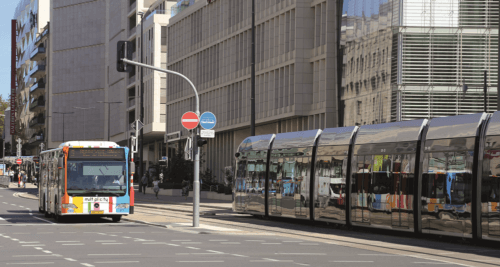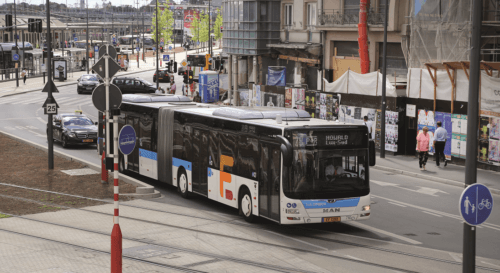
Jonathan Welch reflects on a few bus journeys around Luxembourg, where public transport is free
Regular readers will remember that I visited Luxembourg not long ago to see one of the country’s major operators, Emile Weber, and at the invitation of electrification specialist Furrer+Frey to see one of its All-in-One charging units at one of the operator’s depots. Whilst there, I took the opportunity to sample some of the bus services in the city of Luxembourg to transport me between my airport hotel and the city centre.
As much as I like a ‘proper’ timetable and route map, it was Google Maps and its journey planning facility that presented me with my options; interestingly, I could take a bus from either side of the road towards the main railway station in the city centre, and I tried both. But wait, let’s not overlook the most important thing here; the journeys were free. With rather unfortunate timing, back in February 2020 all buses, trams and trains were made free to use; unfortunate, as the pandemic has prevented a thorough study of the plan’s effects. The idea was not without precedent, and faced with a rising population was intended to quell the use of private cars amongst the 614,000 residents and those who travel in to work in Luxembourg from neighbouring countries, as well as tourists, and increase the number of public transport users by 20% in five years. Of course, the pandemic stepped in before that goal could be reached.
[wlm_nonmember][…]By subscribing you will benefit from:
- Operator & Supplier Profiles
- Face-to-Face Interviews
- Lastest News
- Test Drives and Reviews
- Legal Updates
- Route Focus
- Industry Insider Opinions
- Passenger Perspective
- Vehicle Launches
- and much more!
With an expected loss in fare revenue of €41m (£35m), the scheme did not come cheap, but starts to look much better value when compared to the overall cost of the country’s transport system, around €500m per year, so the additional burden on the taxpayer is relatively small. Prior to the change, fares were €2 for a single journey, or €4 for a day ticket.
Luxembourg was not the first to try the idea; the Estonian capital Tallinn introduced free public transport in 2013 but only for residents. The city estimated extending the scheme to non-residents would cost a further €20m. The northern French city of Dunkirk, with a population of just under a third that of Luxembourg, also introduced free travel in 2018 and reported a dramatic increase in passengers on its buses. A similar scheme was subsequently proposed for Paris, but at an estimated cost of €500 per household was seen as too expensive.

Aboard
My first trip saw me board a Mercedes-Benz Citaro for a lunchtime journey on route 29. I could have caught a 6 or 16, but the Citaro, in the livery of operator Emile Frisch, whisked me easily into the city, first looping around the airport forecourt. With just two others on board, we passed a pair of Citaros in the colourful Luxembourg city network striped livery before continuing, picking up another four passengers outside another airport hotel.
Internal notices in both French and German made me wonder if the bus had been new to an operator in Germany, and looking around suggested a previous life as ‘1186’ in a German fleet before becoming Emile Frisch’s 703.
As we headed city-bound, I was impressed with the driver’s patience in waiting to overtake a cyclist. Less impressive was a rather rough road surface. I was surprised to see an Irish pub, complete with yellow telephone box, nestled below a railway embankment, and after picking up people in twos and threes, we had around 20 on board. The journey took around 25 minutes, and the bus appeared clean and well-presented, both inside and out.

Over the next few days, I made a number of similar journeys, and all showed signs of being well used. There were rarely less than five people aboard, and whilst I didn’t see any buses full to capacity, all of my journeys were off-peak so that’s no surprise. I also took a few trips on the visually impressive single-route tramway, which opened in 2017 and from a passenger perspective was an excellent example of smart, modern urban travel. I couldn’t decide whether the illuminated plastic seat-backs were an interesting example of unusual design, or just a gimmick, but thought they looked good nonetheless.
Returning to my hotel on a late evening journey, and this time via the city’s financial district, I boarded at one of the main city centre stops where real-time information screens appeared to be giving an accurate picture, even if one of them wasn’t working. A clear map showed the city’s routes, making it easy for a would-be traveller to orientate themselves.
As seems common abroad, my hello greeting to the driver as I boarded was barely acknowledged – and with no fares to take, passenger interaction overall seemed minimal. This time, the bus, an MAN artic, was operated by Demy Schandeler, and bore the operator’s yellow livery. I noticed the unusual (to British eyes) layout with seats in the front section raised on a pedestal either side of the aisle; wheelchair users boarded via the centre door.

With a tram running alongside as we crossed the ‘red bridge’ I noted our driver’s relaxed driving style. A large screen gave details of upcoming stops, accompanied by announcements, whilst the roads outside the window seemed quiet. On a number of occasions, I saw our driver looking at what appeared to be a mobile phone whilst we were stationary at traffic lights, and pulling away with it still in his hand, though I’m told that schedules and such like are held on mobile devices, since no ticket machines are fitted. Alongside his relaxed driving style, a relaxed approach to using indicators seemed to be taken, I noticed. The difference in both driving style and attitude often seems noticeable when travelling on the continent, though I sometimes struggle to define exactly what that difference is.
Overall, a few days of travelling on Luxembourg’s buses showed the system to be reliable, clean and efficient. None of the buses I used had any significant delay, and all were well-presented and smoothly driven. For a bus fan, or someone with an operational interest, the city, and indeed the country, could be worth a visit.
[/wlm_ismember]


